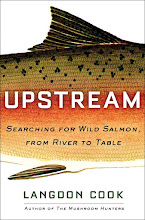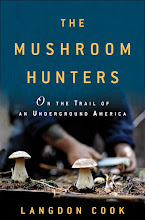My usual oyster mushroom spots aren't producing so well this year. Maybe it's the combination of record winter rain followed by record spring heat. Who knows? Fungi are mysterious.
I've gotten used to kicking off the spring mushroom season with oysters before heading to the dry side of the mountains for morels and porcini. So I tried something new: cultivated oyster mushrooms.
While in Vancouver, BC, to give a talk at the
local mycological society, one of the members, known as
The Mushroom Man, hooked me up with an oyster log. In the past I've found my own wild oyster logs in the woods and fruited them at home, but this was my first attempt with a commercially inoculated log (basically a block of compressed sawdust that's been injected with oyster mushroom spores and incubated in a plastic bag that retains moisture and humidity). I followed the directions, gave the log a good soaking, made a few incisions in the plastic wrapping so it could breathe, put it in a cool corner of the basement—and promptly forgot about it.
A couple weeks later Martha told me I better go check on my log. Sure enough, the enormous caps of fresh oysters were sprouting from the top. I harvested this first flush and watered the log again. A second fruiting is just starting as I type this.
In the past I've made a lot of Asian-style dishes with oysters, like
Bibimbap and
Udon Soup. This time I put them to use in a classic Italian pasta where they went toe-to-toe with a smoked ham hock that had been braised in white wine, chicken stock, fennel, onion, and garlic. The resulting stock became the base of the sauce and was insanely savory, while the tender hock meat paired perfectly with the robust and chewy oyster mushrooms.
Growing oyster mushrooms at home is a fun science experiment, especially for kids, and at the end you get a delicious meal. Just make sure to check your log every day or you may miss the action.
Braised Ham Hock
1 ham hock
1 cup white wine
1 cup chicken stock
1/2 small fennel bulb, chopped
1/2 small onion, chopped
2 cloves garlic, pressed
1/2 tsp black peppercorns
Pasta Sauce
2 tbsp butter, divided, plus extra if necessary
1 large shallot, diced
1/2 pound oyster mushrooms, chopped
1/4 cup white wine
1/2 cup reserved braising stock
1/2 cup heavy cream (or milk or half and half), divided
1/2 cup reserved braised ham hock meat
1/4 cup frozen peas
1 - 2 oz goat cheese
1/4 cup parmesan cheese, grated
8 oz fresh pasta
1. Braise smoked ham hock. I had my butcher saw the hock in half, then I braised it in a small pot with white wine, chicken stock, fennel, onion, garlic, and peppercorns. The liquid should cover about two-thirds of the hock. Simmer, with lid on, for about two hours, checking occasionally to make sure there's enough liquid, until meat falls off the bone. Add more water, stock, or wine if necessary. When meat is tender, discard bone and fat, reserving braised ham. Strain stock and reserve. You should have plenty of meat and some stock left over for another use. Set aside enough meat and stock for pasta, about a half-cup of each.
2. Over medium heat sauté diced shallot in a tablespoon of butter. Add chopped oyster mushrooms and cook together several minutes. Add more butter if necessary. Deglaze with a splash of white wine. Add a ladle of reserved braising stock and a quarter cup (or more) of cream or milk and reduce over low heat.
3. Pre-heat oven to 350 degrees. Add 1 tbsp butter and quarter cup of cream or milk to large pasta bowl and warm in oven.
3. Cook and drain pasta according to directions. Meanwhile add frozen peas, braised ham, and goat cheese to sauce, stir lightly for a minute, and toss with pasta in warm bowl. Finish with grated parm.












